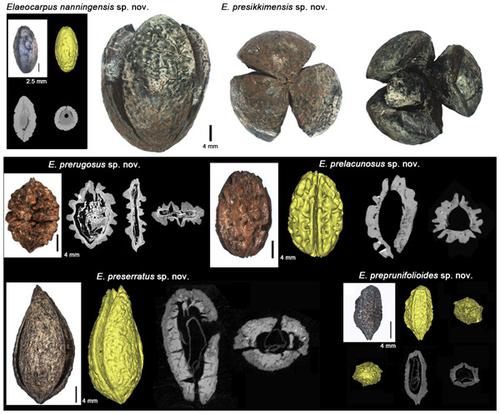当前位置:
X-MOL 学术
›
J. Syst. Evol.
›
论文详情
Our official English website, www.x-mol.net, welcomes your
feedback! (Note: you will need to create a separate account there.)
First fossil fruits of Elaeocarpus (Elaeocarpaceae) in East Asia: Implications for phytogeography and paleoecology
Journal of Systematics and Evolution ( IF 3.4 ) Pub Date : 2020-09-16 , DOI: 10.1111/jse.12684 Xiao‐Yan Liu 1, 2 , Steven R. Manchester 3 , Andrew C. Rozefelds 4, 5 , Cheng Quan 6 , Jian‐Hua Jin 1, 7
Journal of Systematics and Evolution ( IF 3.4 ) Pub Date : 2020-09-16 , DOI: 10.1111/jse.12684 Xiao‐Yan Liu 1, 2 , Steven R. Manchester 3 , Andrew C. Rozefelds 4, 5 , Cheng Quan 6 , Jian‐Hua Jin 1, 7
Affiliation

|
The genus Elaeocarpus contains approximately 360 species and occurs in mesic forest communities from India, through to China, Southeast Asia, New Guinea, Australia, and New Caledonia. Elaeocarpus fossils are best known from the Eocene to the Miocene of Australia and the late Pliocene–early Pleistocene of India, but have not been documented from East Asia before. Here we describe six new species of Elaeocarpus, E. nanningensis sp. nov. from the late Oligocene Yongning Formation of the Nanning Basin, E. presikkimensis sp. nov. from the Miocene Erzitang Formation of the Guiping Basin, E. prerugosus sp. nov., E. prelacunosus sp. nov., E. preserratus sp. nov., and E. preprunifolioides sp. nov. from the late Miocene Foluo Formation of the Nankang Basin in Guangxi, South China. This is the first reliable report for the genus occurring in East Asia, and the fossils indicate that Elaeocarpus had colonized this region by the late Oligocene and represented by a morphologically diverse group of species by the late Miocene. This sheds new insights into the timing and migration patterns of the genus in East Asia. Elaeocarpus is typically a rainforest genus occurring in mesic forests. Based on the habitat of their morphologically similar modern relatives we propose that these three sedimentary basins were warm and wet adjacent to mountainous regions with the evergreen or rain forests during the late Oligocene to Miocene.
更新日期:2020-09-16











































 京公网安备 11010802027423号
京公网安备 11010802027423号